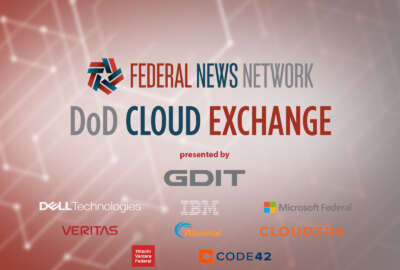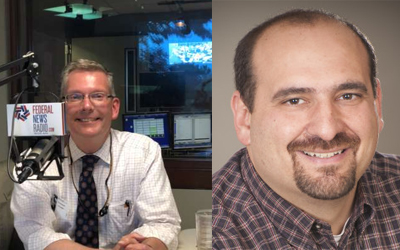
Getting to the cloud can be a challenge, but GSA is ready to help
Getting to the cloud can be a challenge, but there's help. Such as the General Services Administration's Technology Transformation Service.
Best listening experience is on Chrome, Firefox or Safari. Subscribe to Federal Drive’s daily audio interviews on Apple Podcasts or PodcastOne.
For federal agency technology people, cloud computing seems to be, be there or be square. Despite all its virtues, getting to the cloud can be a challenge. But there’s help. Such as the General Services Administration’s Technology Transformation Service. With more, the TTS director of cloud adoption, Calvert Smith, joined Federal Drive with Tom Temin.
Interview transcript:
Tom Temin: Mr. Smith, good to have you on.
Calvert Smith: Hey, Tom, how you doing? Nice to be here.
Tom Temin: You have a view kind of across federal agencies from the GSA perch, so to speak, and how would you characterize the state of cloud adoption? I mean, there’s been a lot of talk for the past number of years. But how deeply into the cloud do you think the government looks at this point?
Calvert Smith: Yeah, this past year has really changed where governments are with cloud, we’ve seen a really big push over this past year with agencies moving more towards modern networking habits, like edge networking, and tech 3.0. We’ve seen a really big push for cloud based collaboration tools. With a pandemic, we’ve got a lot of agencies that are now forced to be more remote friendly with their customers and with their employees. So we’re seeing a lot of agencies push to try and get their employees and everyone connected, better, more collaboration tools, all that past email, but more of working with documents and video and things of that nature to get them really connected easier.
Tom Temin: And review for us, what are the current top vehicles that GSA may offer to help them get there, similar to say the equivalent of the DEOS that is on the DoD side.
Calvert Smith: There’s lots of vehicles out there. And it’s not just about the vehicle, but it’s more about the agency and their needs. With the centers of excellence, when we come in and actually do a discovery to help the agency gauge where they are, and where they need to be, we actually have our own discovery BPA, which we use a lot to bring the agencies and to get them contracts report really quickly. And to help them define those requirements of where they’re going and where they want to go. We use a lot of RFIs and RFQs, to help refine those requirements. But once we have that done, it really depends on the needs that we’ve identified and where that agency needs to be. And we’ll stretch that across any vehicle that’s out there to really get them the best bang for their buck.
Tom Temin: And the GSA adoption office, do you mostly deal with the agencies that maybe have small IT staffs or maybe rely on shared services for most of their work? Or do you also deal with some of the large agencies?
Calvert Smith: Our CLE model is to really meet agency partners where they are in their modernization journey/ We help them accelerate their transformation efforts and give them the right tools and resources to be successful once we leave. And that model really doesn’t matter the size of agency, it can be a bigger agency, like our USDA partner, where we came in with a full contingency of CLE is in leads, and contracts support across cloud adoption, data analytics and customer experience. But also, it could be a smaller agency, like the National Institute of Child Health and Human Development, where we came in really small, and we came in to work with them to build their IT modernization roadmap, and that was just really one CLE. So we’re always here to help any agency no matter the size, and we’ll work with them to build something that works best for them.
Tom Temin: And from a practical standpoint, agencies may have licenses for collaboration tools, and the Microsoft suite, for example, how does that transfer to the cloud? What do you do with those licenses? How do they rationalize all that so that they end up with just the cost that they need for the new cloud based tools?
Calvert Smith: We really encourage agencies to go through some type of CIO application roadmap, or specifically this IO application rationalization roadmap to really take a look at what they currently have, what licenses they have, what technologies and systems that they have within their agencies, identify those, assess them, define what the best roadmap is for moving those licenses or those systems to the cloud, they may be a lift and shift, or maybe there’s license will shift right over into the cloud easily, or those systems, or it may need to be rewritten for the cloud. So identifying what those are setting those priorities and those goals really helps those agencies make better decisions based on resources they have. And no one has unlimited resources. So identifying what licenses they have. And their best route, it’s really important to make sure that prioritization is set.
Tom Temin: And what about the issue of all of the baggage that people have stored? Presentations, emails, Word documents, you name it, and people get a certain finite amount of space in the cloud. Is there a methodology for clearing out the unneeded from that storage container before they move?
Calvert Smith: Absolutely, that kind of goes back to that application rationalization where you’re looking at what you have and what’s best for you. And there’s lots of different cloud strategies to look at when you’re moving that data, some of that data that you need or use on daily basis, maybe you want to move easily to the cloud, but there’s also different migration strategies like an archival platform like glacier or other different things. Pretty cool things within the cloud, different cloud environments that you may want to move them off to that you don’t access every day or every month. So it really depends on what that data is, where it’s going to sit, and how often you’re going to access it to develop a migration strategy that works for it.
Tom Temin: In at least two famous cases, the providers of the collaboration tools, the productivity tools, are also the cloud provider — is it ever possible to separate those two to have tools from one place, and a different supplier of the cloud hosting?
Calvert Smith: Sure, multi cloud strategies are very popular within federal government. Again, it really comes back to the needs of the agencies, what they currently have, where they may be able to go and some of those acquisition strategies. And some of that comes back to the requirements, what current licenses they have, what current applications, the systems that they have, and what’s actually possible and feasible for the agency. So there’s really a mix. And it really depends on what they’re trying to do and where it’s best to get that from.
Tom Temin: And on the assumption that a lot of agencies still have not moved, what’s your best advice for how you get started?
Calvert Smith: Really goes back to that a rationalization and that roadmap, we specialize and one of the things we really like to do with agencies, with the CLE is come in and help build that IT modernization roadmap. What’s that strategy and that roadmap look like for the agency? What system should they prioritize first? What systems are needed for the business values for that agency? And that’s really where you should start. What’s the best value for the agency? Where should they be going and how we can help them get there?
Tom Temin: Yeah, the real theme here is not so much cloud, per se, it sounds like but cloud as a strategy for the real goal, which is modernization.
Calvert Smith: Exactly. It’s really about trying to build better for the agency and help them provide better services for the citizens for their employees. And what’s the best roadmap for that?
Tom Temin: And do they need any documentation as a rule to make sure that they’re getting the savings or the increases in efficiency? I mean, what are the metrics that they want to watch for in the before and after state?
Calvert Smith: There’s always metrics around cloud cost and what you’re moving and how you’re accessing data, and what data you’re moving to the cloud. There’s a shift when you’re moving in a cloud from a capital budget to more operating budget. So the resources are using when you’re moving to the cloud, really need to be geared towards the need. There’s no more buying really big servers to hold a small workload, you would gear that more towards your need, use it as your go and try and shut that down when you’re not using it. So that goes back to that strategy of what’s best for the agency and the systems that you’re moving.
Tom Temin: Calvert Smith is director of cloud adoption at the Technology Transformation Service at the GSA. Thanks so much for joining me.
Calvert Smith: Thank you for having me, I appreciate it.
Copyright © 2025 Federal News Network. All rights reserved. This website is not intended for users located within the European Economic Area.
Tom Temin is host of the Federal Drive and has been providing insight on federal technology and management issues for more than 30 years.
Follow @tteminWFED
Related Stories





